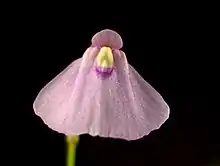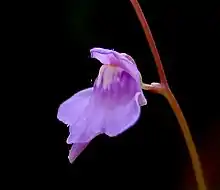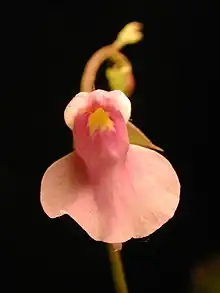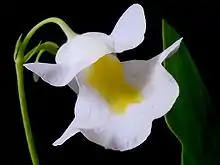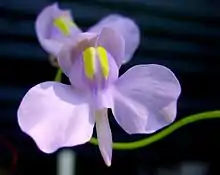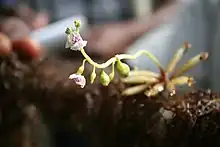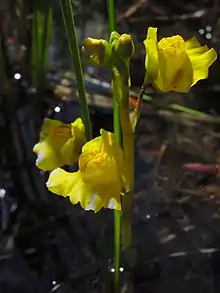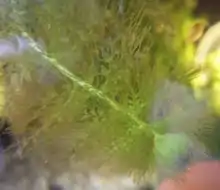List of Utricularia species
There are around 240 species in the genus Utricularia, belonging to the bladderwort family (Lentibulariaceae). It is the largest genus of carnivorous plants and has a worldwide distribution, being absent only from Antarctica and the oceanic islands. This genus was considered to have 250 species until Peter Taylor reduced the number to 214 in his exhaustive study, The genus Utricularia - a taxonomic monograph, published by HMSO (1989). Taylor's classification is generally accepted, though his division of the genus into two subgenera was soon seen as obsolete. Molecular genetic studies have mostly confirmed Taylor's sections with some modifications (Jobson et al., 2003), but reinstalled the division of the genus in three subgenera. This list follows the subgeneric classification sensu Müller & Borsch (2005), updated with new information in Müller et al. (2006).
For a list of known Utricularia species by common name, see Utricularia species by common name.
Subgenus Bivalvaria
Section Aranella
Section Australes
Section Benjaminia
Section Calpidisca
Section Lloydia
Section Minutae
Section Nigrescentes
Section Oligocista
- Utricularia adpressa
- Utricularia albocaerulea
- Utricularia andongensis
- Utricularia arcuata
- Utricularia babui
- Utricularia bifida
- Utricularia bosminifera
- Utricularia cecilii
- Utricularia chiribiquitensis
- Utricularia circumvoluta
- Utricularia delphinioides
- Utricularia densiflora
- Utricularia erectiflora
- Utricularia foveolata
- Utricularia graminifolia
- Utricularia heterosepala
- Utricularia involvens
- Utricularia jackii
- Utricularia laxa
- Utricularia lazulina
- Utricularia letestui
- Utricularia lloydii
- Utricularia macrocheilos
- Utricularia malabarica
- Utricularia meyeri
- Utricularia micropetala
- Utricularia odorata
- Utricularia pierrei
- Utricularia pobeguinii
- Utricularia polygaloides
- Utricularia praeterita
- Utricularia prehensilis
- Utricularia recta
- Utricularia reticulata
- Utricularia scandens
- Utricularia smithiana
- Utricularia spiralis
- Utricularia subramanyamii
- Utricularia tortilis
- Utricularia uliginosa
- Utricularia vitellina
- Utricularia wightiana
Section Phyllaria
- Utricularia brachiata
- Utricularia christopheri
- Utricularia corynephora
- Utricularia forrestii
- Utricularia furcellata
- Utricularia garrettii
- Utricularia inthanonensis
- Utricularia kumaonensis
- Utricularia moniliformis
- Utricularia multicaulis
- Utricularia phusoidaoensis
- Utricularia pulchra
- Utricularia salwinensis
- Utricularia spinomarginata
- Utricularia steenisii
- Utricularia striatula
Subgenus Polypompholyx
Section Pleiochasia
- Utricularia albiflora
- Utricularia ameliae
- Utricularia barkeri
- Utricularia beaugleholei
- Utricularia benthamii
- Utricularia blackmanii
- Utricularia dichotoma
- Utricularia fenshamii
- Utricularia fistulosa
- Utricularia grampiana
- Utricularia hamiltonii
- Utricularia helix
- Utricularia inaequalis
- Utricularia menziesii
- Utricularia paulineae
- Utricularia petertaylorii
- Utricularia singeriana
- Utricularia terrae-reginae
- Utricularia triflora
- Utricularia tubulata
- Utricularia violacea
- Utricularia volubilis
Section Lasiocaules[2]
- Utricularia albertiana
- Utricularia antennifera
- Utricularia arnhemica
- Utricularia bidentata
- Utricularia capilliflora
- Utricularia cheiranthos
- Utricularia dunlopii
- Utricularia dunstaniae
- Utricularia georgei
- Utricularia holtzei
- Utricularia kamienskii
- Utricularia kenneallyi
- Utricularia kimberleyensis
- Utricularia lasiocaulis
- Utricularia leptorhyncha
- Utricularia lowriei
- Utricularia magna
- Utricularia papilliscapa
- Utricularia quinquedentata
- Utricularia rhododactylos
- Utricularia tridactyla
- Utricularia uniflora
- Utricularia wannanii
Section Tridentaria
Subgenus Utricularia
Section Candollea
Section Chelidon
Section Foliosa
Section Martinia
Section Oliveria
Section Orchidioides
Section Setiscapella
Section Sprucea
Section Stylotheca
Section Utricularia
- Utricularia aurea
- Utricularia australis
- Utricularia benjaminiana
- Utricularia biovularioides
- Utricularia bremii
- Utricularia breviscapa
- Utricularia chiakiana
- Utricularia corneliana
- Utricularia cymbantha
- Utricularia dimorphantha
- Utricularia floridana
- Utricularia foliosa
- Utricularia geminiscapa
- Utricularia gibba
- Utricularia hydrocarpa
- Utricularia incisa
- Utricularia inflata
- Utricularia inflexa
- Utricularia intermedia
- Utricularia macrorhiza
- Utricularia minor
- Utricularia muelleri
- Utricularia naviculata
- Utricularia ochroleuca
- Utricularia olivacea
- Utricularia perversa
- Utricularia platensis
- Utricularia poconensis
- Utricularia punctata
- Utricularia radiata
- Utricularia raynalii
- Utricularia reflexa
- Utricularia stellaris
- Utricularia striata
- Utricularia stygia
- Utricularia vulgaris
- Utricularia warmingii
Notes
- Lowrie et al. (2008) notes the placement of section Minutae appears, morphologically, to be closer to subgenus Bivalvaria. This was confirmed by a molecular study (Reut & Jobson, 2010)
- Section Pleiochasia was divided into two sections (Pleiochasia and Lasiocaules) based upon molecular data in a phylogenetic study on subgenus Polypompholyx (Jobson et al., 2017).
References
- Lowrie A, Cowie ID, and Conran JG. (2008). A new species and section of Utricularia (Lentibulariaceae) from northern Australia. Telopea, 12(1): 31-46.
- Jobson RW, Playford J, Cameron KM, Albert VA. (2003). Molecular phylogenetics of Lentibulariaceae inferred from plastid rps16 intron and trnLF DNA sequences: implications for character evolution and biogeography. Systematic Botany, 28(1): 157-171. doi:10.1043/0363-6445-28.1.157
- Jobson RW, Baleeiro PC, Reut MS (2017). Molecular phylogeny of subgenus Polypompholyx (Utricularia; Lentibulariaceae) based on three plastid markers: diversification and proposal for a new section. Australian Systematic Botany, 30: 259-278. https://doi.org/10.1071/SB17003
- Jobson RW, Baleeiro PC, Barrett MD (2018). Six new species of Utricularia (Lentibulariaceae) from Northern Australia. Telopea, 21: 57-77. https://doi.org/10.7751/telopea12630
- Müller KF and Borsch T. (2005). Phylogenetics of Utricularia (Lentibulariaceae) and molecular evolution of the trnK intron in a lineage with high substitutional rates. Plant Systematics and Evolution, 250: 39-67. doi:10.1007/s00606-004-0224-1
- Müller KF, Borsch T, Legendre L, Porembski S, and Barthlott W. (2006). Recent progress in understanding the evolution of carnivorous Lentibulariaceae (Lamiales). Plant Biology, 8: 748-757. doi:10.1055/s-2006-924706
- Taylor, Peter. (1989). The genus Utricularia - a taxonomic monograph. Kew Bulletin Additional Series XIV: London. ISBN 0-947643-72-9
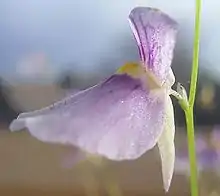
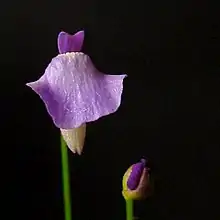
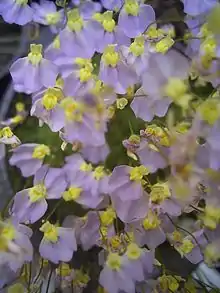
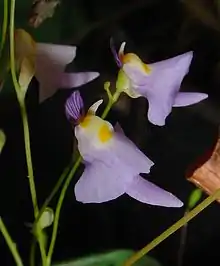
_2.jpg.webp)
